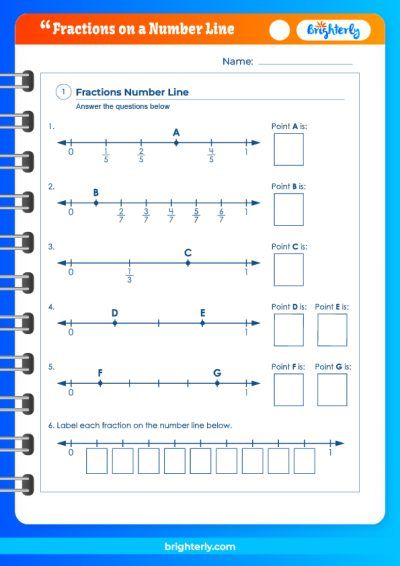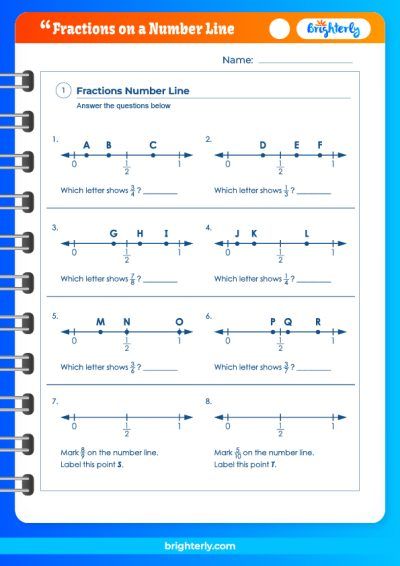Fraction On Number Line – Definition With Examples
Updated on January 10, 2024
Welcome to Brighterly, where we illuminate the path to mathematical understanding for children! Today, we are setting our focus on the fascinating concept of representing fractions on a number line. Fractions, essentially, are the doorways to the world of numbers that are not whole, and number lines serve as the road that these doorways open onto.
A fraction is a numerical quantity that is not a whole number: it’s less than 1 but more than 0. For instance, if you split an apple in two equal parts and take one part, you have 1/2 of an apple. You’ve just used a fraction!
A number line, on the other hand, is a line on which every point corresponds to a real number. If you’ve ever seen a ruler or a yardstick, you’ve seen a number line! In this journey, we will explore how these two mathematical tools intersect, creating a visual means to understand and interpret fractions.
We will dive into the definition and examples of plotting fractions on a number line, comparing fractions, equivalent fractions, mixed fractions, and improper fractions, all within the context of a number line. At Brighterly, we believe in learning through understanding, so we’ll elucidate each concept using clear explanations and illustrative examples. Let’s embark on this mathematical adventure together!
What Is a Number Line?
A number line is a fundamental tool in mathematics, often introduced to children at a young age to help them comprehend the concept of numbers and their relationships. Imagine a horizontal line with equally spaced marks on it, each representing a number. The point marked ‘0’ denotes the origin. On its right, we have positive numbers increasing in value, and on its left, we have negative numbers decreasing in value.
Number lines provide a physical representation of numbers in a visual and straightforward way. They help us understand addition and subtraction, the concept of greater than and less than, and even more complex concepts such as fractions, decimals, and negative numbers. Using a number line, you can literally see how numbers relate to each other. Now let’s dive deeper and understand how to represent fractions on these number lines.
How to Plot Fractions on Number Line?
Plotting fractions on a number line might seem a bit tricky at first, but it’s quite simple once you understand the process.
Start by drawing a straight line and mark the zero point. For the fraction 1/2, for example, make two equal divisions between 0 and 1. The first point after zero represents 1/2.
To plot the fraction 3/4, divide the section between 0 and 1 into four equal parts. The point representing 3/4 would be the third point after zero.
Remember, the denominator (the bottom number in a fraction) tells you the total number of equal parts, and the numerator (the top number) tells you how many of those parts you have. You can use these two numbers to figure out where to place your fraction on the number line.
Comparing Fractions on Number Line
Comparing fractions might seem complicated at first, but a number line can simplify the process. For example, to compare 1/2 and 3/4, plot both fractions on the number line.
You’ll see that 3/4 is to the right of 1/2, meaning it’s greater. If you have fractions with the same numerator, the fraction with the smaller denominator will be larger. On the other hand, if you have fractions with the same denominator, the fraction with the larger numerator will be larger.
By comparing fractions on a number line, you can quickly and visually understand the relationships between different fractions.
Representing Fractions on Number Line
Representing fractions on a number line gives you a visual understanding of the value of the fraction. The point for 1/2, for example, will be exactly halfway between 0 and 1 on the number line.
Similarly, the point for 3/4 will be three-quarters of the way between 0 and 1. This visual representation makes it easier to understand the relative size of different fractions, and how they relate to each other and to whole numbers.
Equivalent Fractions on Number Line
Equivalent fractions are fractions that have different numerators and denominators but represent the same quantity. For example, 1/2, 2/4, and 3/6 are all equivalent because they all represent half of a whole.
On a number line, these fractions will all be plotted at the same point, halfway between 0 and 1. This helps to visualize the concept of equivalent fractions, and to understand that different fractions can represent the same value.
Mixed Fractions on Number Line
A mixed fraction is a whole number combined with a fraction, like 1 1/2 or 2 3/4. To plot a mixed fraction on a number line, first locate the whole number. For example, if you’re plotting 1 1/2, start at the point for 1. Then, divide the space between 1 and 2 into two equal parts (because the denominator is 2), and locate the point halfway between 1 and 2. That point represents 1 1/2.
Similarly, to plot 2 3/4, start at the point for 2, divide the space between 2 and 3 into four equal parts, and locate the point that’s three-quarters of the way between 2 and 3.
Improper Fractions on Number Line
Improper fractions are fractions where the numerator is greater than the denominator, like 7/4 or 9/2.
To plot an improper fraction on a number line, determine how many whole numbers the fraction contains and plot that point. For example, 7/4 contains one whole number (because 4 fits into 7 once), so start by plotting the point for 1.
Then, divide the space between 1 and 2 into four equal parts (because the denominator is 4), and locate the point that’s three-quarters of the way between 1 and 2 (because there are 3 parts left over from the 7). That point represents 7/4.
Fractions on a Number Line Worksheet PDFs
Using worksheets is a great way to practice plotting fractions on a number line. We’ve created a series of fractions on a number line worksheets in PDF format, which you can download and print for your child to practice with.
These worksheets include simple fractions, mixed numbers, and improper fractions. They’re a great way to reinforce the concepts we’ve discussed in this article, and to help your child become comfortable with fractions.
Discover the wonders of Math!
Through the use of number lines and the visualization of fractions, we can discover the wonders of math. It not only helps us understand the concept of fractions but also aids in solving more complex problems.
Proper Fractions on a Number Line
A proper fraction is a fraction where the numerator is less than the denominator. To plot a proper fraction on a number line, divide the space between 0 and 1 into a number of equal parts equal to the denominator, then count off a number of these parts equal to the numerator.
For example, to plot 3/4, divide the space between 0 and 1 into four equal parts, and then count off three of these parts.
Solved Examples on Fraction on a Number Line
-
Plot 1/2 on a number line:
Draw a straight line and mark the zero point. Then mark a point that represents ‘1’. Now, divide the space between 0 and 1 into two equal parts as the denominator of our fraction is 2. The first point after zero represents 1/2.
-
Plot 3/4 on a number line:
Just like before, draw a straight line and mark points for 0 and 1. This time, divide the space between 0 and 1 into four equal parts (since the denominator is 4). The third point after zero represents 3/4.
-
Compare 1/2 and 3/4 on a number line:
Plot both 1/2 and 3/4 on the number line as explained before. You will see that 3/4 is to the right of 1/2, which means it is greater than 1/2.
Conclusion
We, at Brighterly, hope that this comprehensive exploration of fractions on a number line has shed light on this crucial mathematical concept. Understanding how to represent, compare, and interpret fractions on a number line is a foundational skill in mathematics, and we’re confident that this guide will serve as a valuable resource in your child’s mathematical journey.
Remember, like any language, the language of mathematics is best learned through practice. So, encourage your child to keep exploring and practicing the concepts we’ve discussed here. We believe in learning at one’s own pace, so if a concept seems challenging, it’s perfectly okay to take a step back, review, and try again.
Mathematics is a journey, and every journey moves one step at a time. With each concept your child masters, they’re not just learning math—they’re learning how to think logically, solve problems, and understand the world. Keep up the great work, and remember, the team at Brighterly is always here to illuminate the path of learning!
Frequently Asked Questions on Fraction on a Number Line
What is a fraction on a number line?
A fraction on a number line represents a division of a whole into equal parts. For example, the fraction 1/2 on a number line is a point that is halfway between 0 and 1. Fractions help us understand numbers that are not whole, and placing them on a number line provides a visual representation that can make these concepts easier to understand.
How do you plot fractions on a number line?
To plot a fraction on a number line, first draw a line and mark off the whole numbers. Then, choose a fraction you want to plot. The denominator of the fraction tells you into how many equal parts the space between the whole numbers should be divided. The numerator tells you how many of these parts you have. For example, to plot 3/4, divide the space between 0 and 1 into four equal parts, and count off three of them.
Why is it helpful to use a number line to compare fractions?
A number line can be a useful tool to compare fractions because it provides a visual representation of their sizes. By placing fractions on the number line, you can easily see which is larger or smaller based on their position on the line. It’s a more intuitive way to compare fractions than simply comparing numerators and denominators.
What are equivalent fractions on a number line?
Equivalent fractions are fractions that have different numerators and denominators but represent the same value. On a number line, equivalent fractions will fall on the same point. For example, 1/2, 2/4, and 3/6 are all equivalent fractions, and they all would be represented by the point halfway between 0 and 1 on the number line.






